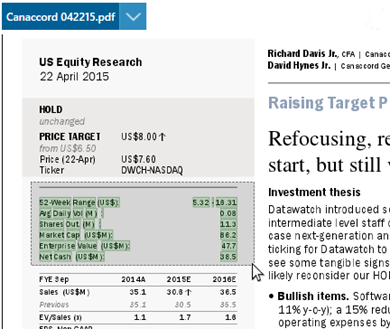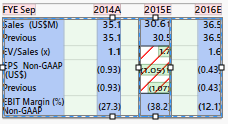Modifying Tables
Monarch Table Extractor allows you to modify and tweak a table definition that was automatically defined.
You can:
-
define a new table,
-
create a new column,
-
delete columns,
-
exclude values from a table,
-
combine tables,
-
define a table title,
-
modify headers,
-
delete spaces from header and table values.
Defining a new table
You can define a table yourself without having Monarch Table Extractor define it automatically.
Sometimes, Monarch Table Extractor may miss a table during a Find Tables operation. In such cases, you can add the table manually.
Steps:
-
Via drag-and-drop, select the area containing the values you want to define as a new table.
-
Select Table from Selection.

A context-menu displays:

If you select an area where other tables have already been defined, a different context-menu may be displayed:

You may need to select More Options at the bottom of the context-menu to display this option.
Selected values become a new table.
Monarch Table Extractor applies standard logic and tries to determine the rows and columns of the new table.
Creating a new column
Monarch Table Extractor may sometimes miss a column. You can easily rectify this by adding the column manually.
Steps:
-
Via drag-and-drop, select the area containing the values you want to define as a new column. The values must be text inside a table, or adjacent to a defined table.
-
Select Create new column.
A context-menu displays:

Selected values become a new column. These should be highlighted in green when the table is selected, and display as new column values on the Table panel.
Deleting a column
Steps:
-
Select the table on the document area.
-
Click on the column you want to delete.
-
Hover your mouse over the column until an X mark appears:
-
Click the X to delete the column.
The table should be outlined by a box with drag handles:

The column should now also be outlined by a box with drag handles:


Excluding column values
Steps:
-
Select, via drag-and-drop, the area containing the values you want to exclude.
-
Select Exclude from Table.
A context menu displays:

The highlighted values are now enclosed in a striped box:

The values inside the box are no longer displayed on the table on the Table panel.
Appending tables
Monarch Table Extractor allows you to combine data from two tables on the same page via an append as long as the selected columns match the append criteria. Note that the data types of the columns to be appended do not need to match for the append operation to proceed. In this case, the column containing different data types is converted to string.
Steps:
-
Select the two tables you want to combine by highlighting them.
-
From the menu that displays, select Append Tables.

Data from the two tables, as defined by the overlap, are combined into one table in the Table panel. If the tables to be appended to not match in terms of number of columns, the append command does not display.
Combining columns
Monarch Table Extractor allows you to combine the data from adjacent columns to expand the information captured by a single column.
Steps:
-
Select the table.
-
Select the first column you want to combine so that it is highlighted and drag handles are displayed:
-
Drag a handle so that the area of the first column overlaps that of the second column (or the other columns you want to combine).


Data from the columns, as defined by the overlap, are combined into one column on the Table Panel. Rename the columns as needed. Refer to Modifying Headers.
Defining a table title
You can create new table captions using the report text.
Steps:
-
Select text directly above a table.
-
A context menu displays:
-
Select Set Table Title.

Selected text becomes the name of the table on the table panel.
Modifying headers
In Monarch Table Extractor, you can modify headers in several ways.
MODIFYING HEADERS
Steps:
-
Select the table.
-
Select a blank area between column values until drag handles display and headers and columns are highlighted with a different color:
-
Right-click on the header to display a context menu.
-
Select Modify Headers.
-
Do the following:
-
Enter a pre-fix if you want a prefix to better identify the column.
-
Enter a value into Header Root if you want to modify the header value.
-
Select Apply.

The Modify Headers dialog box displays:

Header changes are reflected on the table definition in the Table panel.
DEFINING A HEADER COLUMN
Steps:
-
Select a table.
-
Select text above the table.
-
A context menu displays:
-
Select Column Header.
You can select header text even with space or other text between the table and the candidate header row.
For example:


The selected text are associated as column headers of the table, and are displayed as such on the table panel.
DEFINING A ROW HEADER
Steps:
-
Select text at the left side of a table or the first column on the table.
-
A context-menu displays:
-
Select Row Header.

The selected text becomes the column headers of the table on the table panel.


